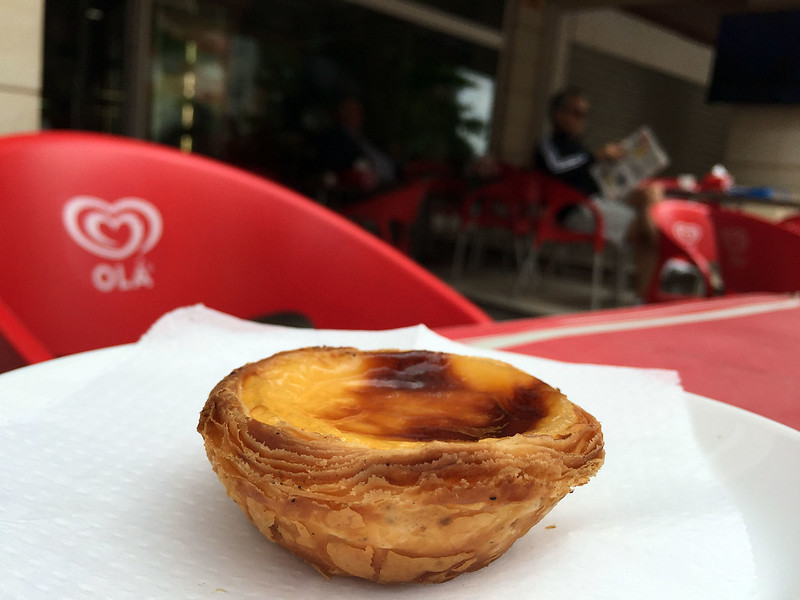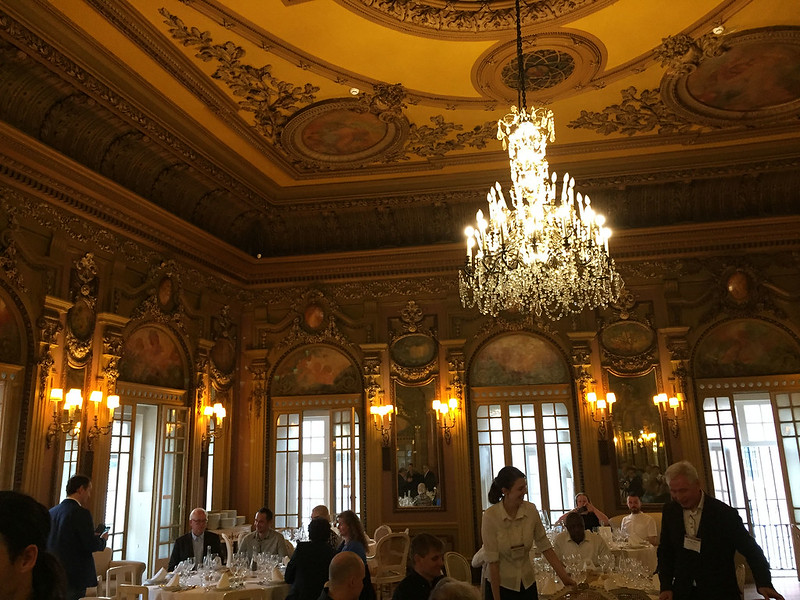
Pastel de nata from Pasteleria Lirio do Campo
[ <<previous | index | next >> ]
15:54
I am back at the hotel after the ISO meeting has adjourned a bit early. M. is still out exploring Lisbon.
After getting up and having breakfast as usual this morning, I went to the meeting, while M. prepared a bag of laundry to be cleaned. The hotel laundry service is ridiculously expensive, charging 3.40€ for each pair of socks and 3.90€ for each pair of underwear. With conversion we'd have ended up paying something like $60 or $70. So instead we threw all our dirty clothes in a bag and I looked up drop-in laundries nearby. There were a few within walking distance, including one right at Roma metro station, which was convenient for where M. wanted to go this morning. I wrote a note in Portuguese (using Google Translate) in case nobody at the laundry spoke English, requesting a wash and dry and asking if we could pick it up after 17:00 today. So M. planned to drop that in at 09:00 when the laundry opened and then head into town to check out the Mercado da Reibera and some more of the neighbourhoods around the city.
Meanwhile I was back at the university for the final technical session, which was a preliminary report on standards for high dynamic range (HDR) image coding. There are several standards for HDR video, but none yet for still pictures, and we think we should get started on making one. There was a lot of technical discussion on colour management and rendering. Colour seems like such a simple concept, but every time I see the technical details it reminds me just how complicated it is.
After this we had the closing administrative session for the WG 18 meeting. Next was the scheduled plenary administrative working group meeting session 2, to be held over lunch from 12:15. Since we wrapped up the WG 18 stuff by 11:00, I had an hour to kill. I took a walk north through a neighbourhood I hadn't explored yet. It was largely residential, with apartment blocks linked by quiet streets. But on the ground floors of many of them were small shops to service the residents, including several pasteleria/cafes.
 Pastel de nata from Pasteleria Lirio do Campo |
I stopped in at four of them and ordered a pastel de nata, the famous Portuguese custard tart, at each one. I figured I'd make this an exploration of the different bakeries and compare the tarts. The prices were all different, in order 0.95€, 1.10€, 0.90€, and 1.00€. They were all good, but the third one was distinctly not as good, with the pastry being not as fresh and flaky. I walked past three other pastelerias as well, but after four tarts I didn't feel like I should eat any more before lunch!
 Pastel de nata from Pasteleria Princesa do Lumiar |
The catered lunch was mediocre again, although this time there was also a cake for dessert, though I didn't have any, having had my fill of sweets just an hour before! I had a slice each of the quiches, which I think both had chicken in them, a couple of small croquette balls, and a bit of green salad. I made sure to get plenty of water too, since there was no other way to get a drink other than a vending machine or drinking from the toilet sink taps again.
Finally we had the plenary closing session, which was again largely administrative. We finished well before the agenda closing time of 17:00, so I have a couple of hours to rest, and wait for M. to return from her outing.
Written next day
M. returned to the hotel about 17:00. She'd come back earlier from her trek to the neighbourhoods east of Martim Moniz and around the Mercado da Reibera, and looked for something else to go see. She decided to check out a major department store, finding El Corte Inglés at São Sebastão. She said it was pretty much like every department store, but it was fancy enough to have a fur section.
After returning, M. had a shower while I walked over to Roma to pick up our laundry. I had a little trouble spotting the laundry, since it was around a corner from where I expected it. Thankfully M. had found it okay this morning. I gave the lady the ticket and she returned with our washed clothes. It was lucky I'd written the note for M., as indeed nobody there spoke any English. When I got back to the hotel, I had my shower, then we got ready to leave for dinner.
 Rossio Square |
We arrived at Restauradores station around 18:30, giving us an hour to wander around the area, just north of Rossio square. We passed the restaurant where the dinner was: Casa do Alentejo. It was a very subtle door with no obvious signs that it was a restaurant, nestled amongst a gaggle of incredibly touristy restaurants with outside tables, picture menus in four languages, and spruikers trying to rope tourists into sitting down for a meal. One woman tried to convince us to eat at her establishment twice, as we walked past first in one direction and then returning a few minutes later.
 Rua das Portas de Santo Antão, north of Rossio Square |
There were a lot of university students around, similar to the ones we'd seen in in the park near the meeting venue (and the universities). I don't know what they were doing here in the middle of town. I realised that it must be the end of the academic year here, so maybe they were celebrating the end of exams. At the northernmost end of our wandering we found the funicular tram of Calçada do Lavra, which ascended the steep street to the hill above.
 Funicular Lavra, Calçada do Lavra |
Close to 19:30 we entered the Casa do Alentejo doors, which led to a staircase leading upstairs, depositing us in a very ornate and old looking Moorish courtyard, with a fountain in the middle and walls with wooden archways carved in intricate Moorish geometric patterns supporting windows looking down from rooms above on the next floor. Since the dinner was joint with the Archiving conference, there were a lot of people there, most of whom I didn't know. By the time we sat down for dinner it must have been a hundred or slightly more people.
 Casa do Alentejo lobby |
Before dinner though the restaurant served drinks and hors d'oeuvres. They had red and white port, which we thought was unusual as a pre-dinner drink. We tried the red, and it was more subtle than the ports I've tried before, retaining some of the tannin and complexity of the red wine and with a restrained sweetness that didn't make it as raisiny as other ports. Neelam joined us and we all agreed it was very good, but Dietmar and Eric said they had done a port sampling last night, with 20 year old port that was amazing. After finishing our glasses, we tried the white port, but it was more syrupy and not as interesting. The finger food included tomato and cheese skewers, fruit skewers, small samosas, and some sort of croquette balls that were so crumbly that several people tried to pick them up, only to have them crumble in their fingers and fall back onto the platter. They tasted of fish to me, but the waitress when asked denied they had fish or meat in them, but also couldn't tell us what was in them.
After this we were herded upstairs another floor to the dining room. This was an amazing room, decorated like a 19th century palace, with chandeliers, fancy panelling, and giant mirrors. We sat at a table of nine people, with Neelam, Klaus and his wife Erika, Ari, and Teru from Finland, and two people from the Archiving conference, a woman from Netherlands and a guy from Czechia. On the table was bread, with two types of cheese and prosciutto to go with it. There were also menus listing the dishes and all the ingredients.
 Casa do Alentejo dining room |
The first course was asparagus soup, which also had potato in it to thicken it up. The serving for all the courses was done at the table, with waiters bringing around tureens of soup and ladling it into bowls in front of us. The next two courses were perch fillet in shrimp sauce (perch, olive oil, onion, garlic, salt, tomato, green peppers, white wine, bay leaf, sweet chilli, black pepper), and then pork tenderloin with rosemary and honey sauce, served with a spicy rice, and these were served from large silver platters, the waiters using tongs to place the items onto our plates.
There was white and then red wine, but both were workmanlike and uninspiring. The fish and the lamb were both decent, and the rice very nice. Dessert was sericaia cake with elvas plums, a traditional style of cake, thin and flat and textured like a semolina or polenta cake, with cinnamon on top, served with a candied plum. I liked it, but Neelam said it was too sweet. M. and the woman from the Netherlands had "vegan" cards in front of them, and waiters brought them special courses: a tofu and vegetable curry on rice, and then a warm potato salad. And the vegan dessert was a chocolate and peanut butter slice, which was very peanutty.
 Sericaia cake |
Before the dessert though, the organiser of the Archiving conference got up to make a short speech of welcome and thanks for attending, and then she introduced a singer who played guitar and sang a few Portuguese songs, including some traditional ones and ending with a couple of modern pop songs. He was very good.
Dinner ended around 23:00. We walked with Neelam to Restauradores station, but she said she needed to go to Campo Grande, on the green line, so I said she'd be better off walking the extra 100 metres or so to Rossio, which was on the green line, rather than having to change lines twice from Restauradores. So we said goodbye, not knowing when we'd see one another again, but presumably at another ISO meeting in the future.
M. and I returned to or hotel and simple brushed our teeth and hopped straight into bed.
[ <<previous | index | next >> ]